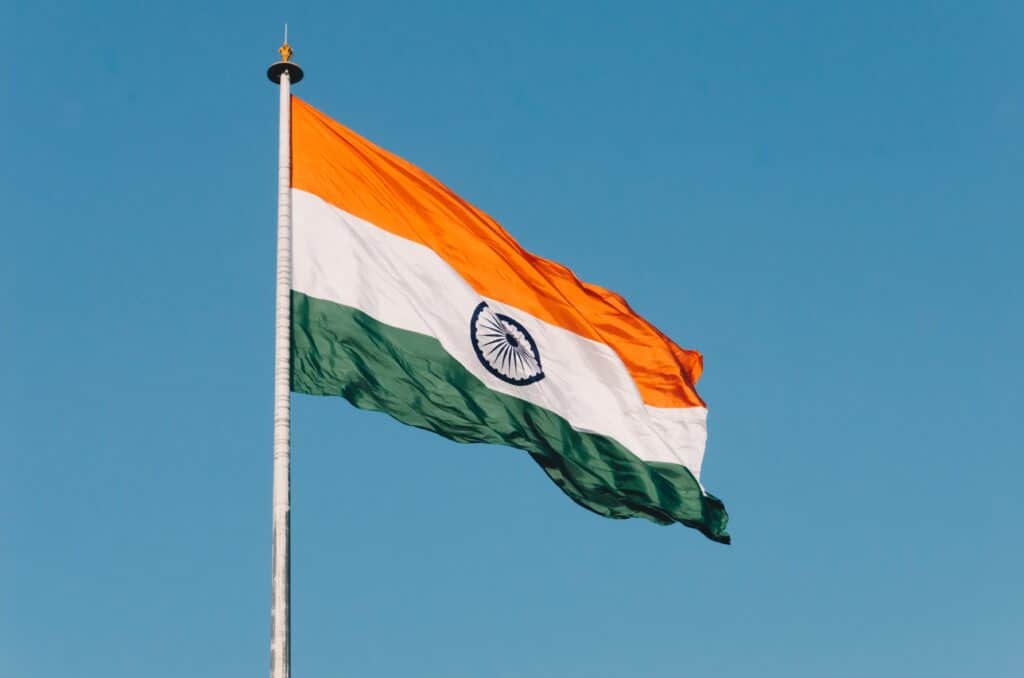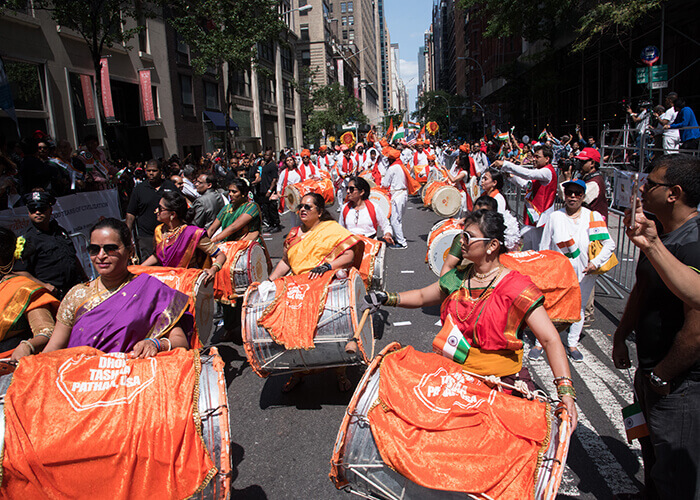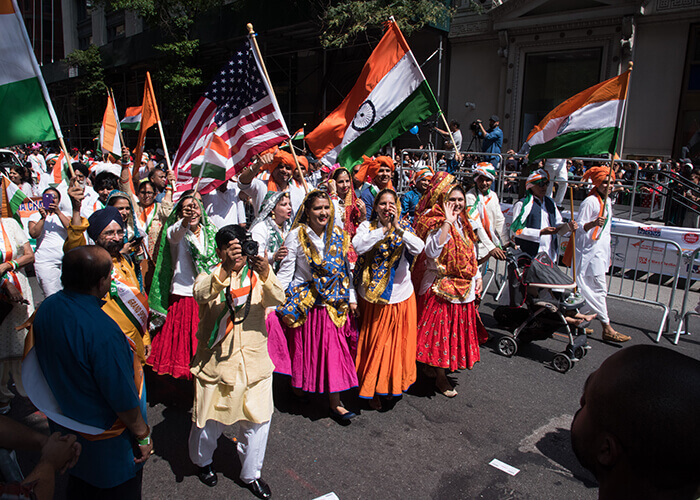
August 15th is a very special day for India because it marks the anniversary of the country’s independence from the British Crown in 1947. India Independence Day, also known as India Day, is a call for celebration.
With parades and tributes held across the country, people commemorate this national day by waving India’s tricolor flag from rooftops, spending time with family and close friends, and celebrating India’s many rich, diverse cultural traditions. In celebration of the annual observance, our team here at Remitly put together this guide to the holiday.
A brief history of India’s Independence Day
India’s independence was officially declared in 1947, but the Indian independence movement began long before. India Day is a time to not only celebrate the end of British colonial rule but also to pay tribute to the many freedom fighters who fought and died on the path to independence.
To understand the history of the national holiday, it’s important to know a little background about British India and the events that led up to the day when India gained independence.
The first half of the 19th century marked the start of British colonialism. At that time, the influence of the East India Company greatly expanded in the various states that make up India today. British officials were taking over key positions in more places, replacing local leaders.
Concerns about the expansion of Western influence resulted in an armed conflict between Indian troops who worked for the East India Company known as sepoys. This uprising was the First War of Independence, sometimes called the Indian Mutiny, the Sepoy Rebellion. It occurred in 1857 and was ultimately unsuccessful.
When the First Independence War ended, the British Crown took complete control of India. The British government became responsible for ruling the entire country rather than power being largely in the hands of the East India Company.
In 1919, a British judge passed the Rowlatt Act, a piece of legislation that allowed the British government to imprison anyone suspected of terrorism indefinitely and without a trial. This act discouraged revolt against British rule and made it more difficult for the people of India to gain independence.

Due to growing feelings of protest, the judge enforced several bills that became known as the “black bills.” Each one gave even more power to the British government. People described these bills as “No Dalil, No Vakil, No Appeal,” or “no pleas, no lawyer, no appeal.” In response to the new legislation, activists launched a series of peaceful protests.
The leader of the opposition was an Indian activist named Mohandas Karamchand Gandhi, also known as Mahatma Gandhi. He believed in the power of nonviolent resistance through civil disobedience, and Gandhi’s influence helped lead the country to a revolution to ultimately gain independence from British rule. He is still revered in India for his work and teachings and is known as the Father of India.
On August 8, 1942, Gandhi launched the Quit India movement, or the India August Movement, at a session of the All-India Congress Committee. Three years later, Japan’s surrender would mark the end of the second world war. The aftermath of the two world wars changed attitudes about colonialism, and shifting beliefs led to many European countries ending colonial rule.
India finally gained their freedom from British rule upon signing the Indian Independence Act of 1947. Jawaharlal Nehru became India’s first prime minister, and Lord Mountbatten served as the governor-general.
To mark the occasion of independence, Jawaharlal Nehru delivered a rousing speech, which many call one of the greatest political speeches of the 20th century. Its opening lines are particularly memorable. The speech began with, “Long years ago, we made a tryst with destiny, and now the time comes when we shall redeem our pledge, not wholly or in full measure, but very substantially. At the stroke of the midnight hour, when the world sleeps, India will awake to life and freedom.”
How is Independence Day celebrated in India?
On the eve of India’s Independence Day, the President of India delivers an “Address to the Nation.” On the morning of Independence Day, the prime minister of India speaks to the country just as Jawaharlal Nehru did in 1947.
During the speech, the prime minister hoists the national flag of India over the Red Fort, a historic site in the Old Delhi neighborhood of New Delhi. A 21-gun salute follows.
The prime minister then gives a speech over the ramparts highlighting the past year’s achievements and urging the country to move forward together. The ceremony also pays tribute to the leaders of the Indian Independence movement by singing the Indian national anthem, “Jana Gana Mana,” and other patriotic songs.
Many other flag-hoisting ceremonies occur in Indian state capitals, other major cities, and smaller towns and villages. In many cities, there are parades that portray the struggles of the independence activists and showcase the diverse cultural traditions of India. Many major, government office buildings and post offices are strung with lights, and tricolor flags adorn clothing, cars, and houses as a symbol of patriotism.
While the flag ceremony is the official way India celebrates Independence Day, kite flying is a more informal method of honoring the day. Before India became an independent nation, freedom fighters in Old Delhi often flew kites decorated with slogans protesting Indian rule. Today, kite flying is seen as a way to pay tribute to Mahatma Gandhi and the other revolutionaries who paved the way for independence.

Partition Horrors Remembrance Day in India
India now holds a national memorial day called Partition Horrors Remembrance Day on the day before Independence Day. It first occurred in 2021 under the leadership of Prime Minister Narendra Modi.
The purpose of the memorial day is to remember those killed and displaced during partition. The region was divided into two countries when India gained its independence: India and Pakistan. Due to the formation of separate states, millions of people were forced to leave their homes and relocate to Pakistan.
Although the holiday is still new, city governments, various groups, and post-secondary educational institutions have begun to organize cultural events to remember those affected by the partition. In 2022, the metro system in New Dehli put together a photo exhibit in honor of the occasion.
India Independence Day celebrations outside of India
More than 13 million Indians live outside of India, and many celebrate the day that India became an independent nation in their new countries. Read on to learn how India’s independence day is celebrated in other parts of the world.
U.S.
India Independence Day has become a widely celebrated day in America, especially in urban metropolitan areas with large populations of Indian Americans.
The largest India Day Parade outside India is the New York City Parade. Each year, the Federation of Indian Associations hosts tens of thousands of people who participate in a celebration of all things India, with dozens of vendors, dance performances, music, and speeches.
The mayor of New York City usually leads the parade, and special guests are often invited to speak, such as Bollywood stars and local elected officials. The New York legislation declared August as Indian American Heritage Month in honor of India Day.
Other cities across the United States, such as Los Angeles, Seattle, Boston, and Chicago, also host festivals and events in celebration of India Day. The state of Minnesota proclaimed that August 15th would be known statewide as “India Day.”

UK
Although India won independence from Britain, India Day is also celebrated in the UK. The High Commission of India and Indian community organizations typically hold an event celebrating the day.
To mark the event’s start, a high-ranking official like the High Commissioner of India to the UK will raise the tri-color Indian national flag and give a speech. Then, people sing patriotic songs, and the rest of the day is devoted to cultural programs like dance performances and music concerts.
Canada
India Day celebrations are also common in Canada, and in 2021, the country took huge steps to congratulate India on 75 years of independence. Across Canada, major landmarks like Niagara Falls and the CN Tower in Toronto were illuminated in tricolor lights, and city halls flew the Indian flag. In addition, Prime Minister Justin Trudeau gave a speech to mark the occasion.
Toronto is home to one of the largest India Day celebrations in Canada. Typically, the day begins with a large parade. Then, a festival takes place in Toronto’s Nathan Phillips Square with food, dancing, and music.
Australia
Australia is another place where many people celebrate India’s independence on August 15. Canberra, Sydney, Melbourne, Brisbane, and Perth are all home to large celebrations, including flag ceremonies and other festivities.
In smaller towns across Australia, Indian-Australian communities organize other events. Many will hold India-Australia friendship fun fairs with food, performances, and games, with the events open to everyone in the towns.
Ways to observe Indian Independence Day
Even if you’re not of Indian heritage, you can pay tribute to India’s independence on August 15 in your own way. Try sampling authentic Indian cuisine or watching Indian movies like Bollywood musicals.
Check local websites and newspapers for information about Independence Day celebrations in your area and plan to attend one. It’s also a great time to donate to NGOs and nonprofits working in India.
Sending money to India for Independence Day
Many Indians living abroad choose to send money home to loved ones around Independence Day. If you’re one of them, Remitly can help make money transfers quick and simple.
And on behalf of everyone at Remitly, Happy Independence Day!
Visit the homepage, download our app, or check out our Help Center to get started.